Mapping apps in Google Play Store: what do gender representation and sexuality look like?
Lead: Ana Marta M. Flores (UC/ICNOVA) and Elena Pilipets
Team members: Sofia Caldeira, Alessandro Quets and Nabeel Siddiqui
Final presentation slides
Key Findings
Introduction
Research Questions
Query Design & Visual Protocol
Methodology
Findings
Discussion
References
Key Findings
- Men query practically does not overlap with other queried gendered categories (different types of apps, different visualities, etc)
- Most apps in the men’s query are not overtly gendered, but rather indirectly gendered (e.g. through genre, like fighting games, that rely on stereotypical conceptions of masculinity) … apps that are directly gendered tend to be about topics or practices typically presumed not to be “manly”, for example, fitness… for men or kegel exercises… for men
- The women query finds parallels with the *queer* queries, particularly when it comes to dating … yet, apps directed at women rely not only on the connection between gender and sexuality in this facet but also connect womanhood with bodily and appearance concerns (reinforcing existing assumptions)
- Looking at the genderqueer queries (agenero/nao-binario/transgenero), the analysis of unique apps shows a strong presence of the same apps across the three queries. Suggestions for Men-related apps tend to have no overlaps with other gender queries.
- Implied sexualisation of queerness, with apps found in the gender-queer queries often heavily linked to dating (this could link to future research, e.g. on the PEGI ratings of apps)
- Queer genders are highly present in the dating category (see app recommendations)
- Visibility and invisibility – the visibility of queer genders according to Google Play are mediated through the ecology of dating apps.
- Queer apps are also strongly related to games, you either act your queerness through dating or roleplay it in games
- The male and female sexuality are more strongly connected to the other everyday areas of sexual difference, like fitness and health. These male and female apps are more present in the more normative everyday mundane aspects.
- The queer gender is not yet visible in the normative construction of everyday life, e.g. fitness, entertainment, etc.
- Even though the app creation “industry” is quite new and open to innovation, it still has a lack of representation reflected in the app sphere.
Gender and sexuality issues are indeed much more complex than the traditional binary and heteronormative system suggests in most societies. Considering gender as a social construction and the power relations they enact (Butler, 2004), our interest lies in understanding how gender and sexuality are represented in the offer of apps in the Android (Play Store) system shops in a specific clipping.
The relevance of the study is in exploring the context of this market in Portugal, by recognizing that collective narrative processes on app-based platforms enhance power relations by perpetuating hegemonic masculinities and femininities anchored upon heteronormativity (Amaral et al., 2020), simplifying the world as merely binary.
- Gender and sexuality issues are indeed much more complex than the traditional binary and heteronormative system suggests in most societies;
- Our interest lies in understanding how gender and sexuality are represented in the offer of apps in the Android (Play Store) in Portugal.
RQ1: What are the visual and textual expressions related to the apps when searching for the terms mulher (woman), homem (man), agénero (agender), transgénero (transgender) and não-binário (non-binary)?
RQ2: Which apps are present across the genders?
RQ3: What inferences about gender and sexuality can we make based on the app store similar apps recommendations?
Query Design & Visual Protocol
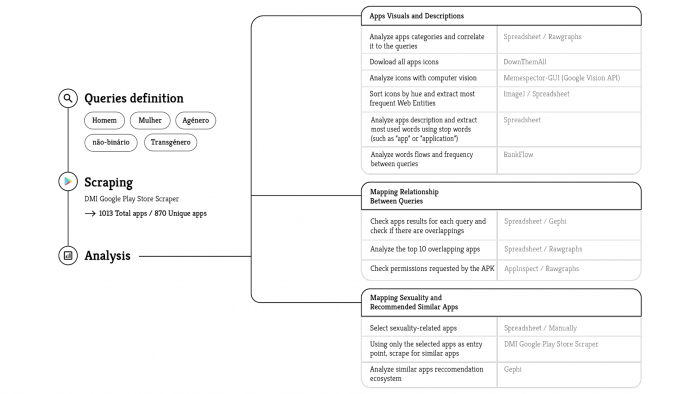
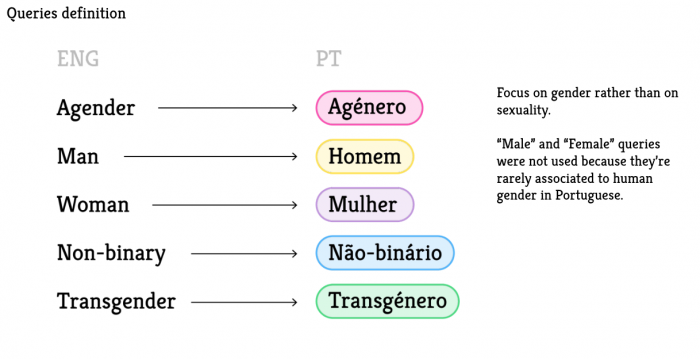
Image montage | Arranged by 5 gender queries & color similarity
- 1012 images were grouped in accordance with 5 gender queries and sorted by color in Google Spreadsheets (using ImageJ measurements “median hue”)
- The .csv file was downloaded as .tsv file and used as an input for ImageJ’s ImageMontage macro
- The purpose of this visualisation is to highlight gender-specific color arrangements and patterns of repetition in app icons
Web entity analysis/image content
- Content analysis for each query-specific image group was performed using both manual exploration and computer vision (by calculating and visualizing the top 10 most frequently appearing entities per image group). Google Vision API was accessed using Memespector GUI.
Top words in the description
- Filtering spreadsheet by gender category, then copying all descriptions into Tag Crowd. The top 50 words and their frequencies were copied into the spreadsheet.
- Creating word-size visualisation: frequency of word repetitions was used to define the font size in Figma. More repetitions of the same word can imply a more homogeneous category of apps (e.g. the men category).
- Rank flow chart: Created using the Rank Flow tool (https://labs.polsys.net/tools/rankflow/). The top 50 words (from Tag Crowd) were manually cleaned up, grouping synonyms words (e.g. game and games) and also words in different languages (e.g. women and mulheres). The same number of words (N=38) was used for all columns.
Presence of Apps across gender queries
- The analysis of unique apps shows a strong presence of the same apps across queer gender queries. Suggestions for Men-related apps tend to have no overlaps with other gender queries.
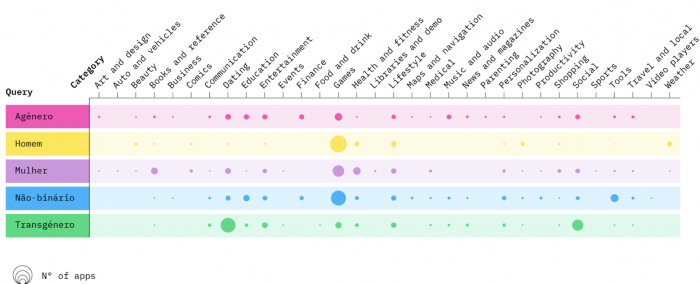
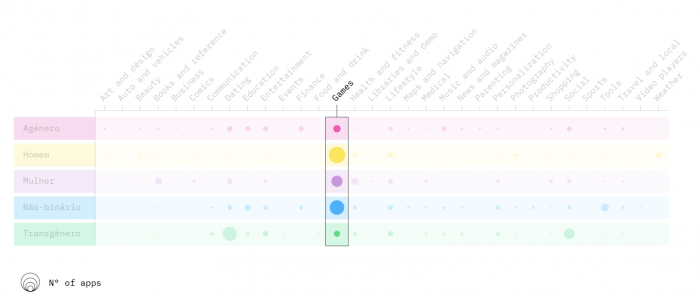

Looking at the number of apps per category across our five gendered queries, we can see that within the play store different genders are directed towards different types of apps (with different aims). While games are very present across all the gendered queries, this category is the most visible in the men query. On the other hand, the transgender query shows mostly apps categorised as dating or social (implicitly linking transness with sexuality), this can be contrasted to the men’s query, with these categories practically absent.
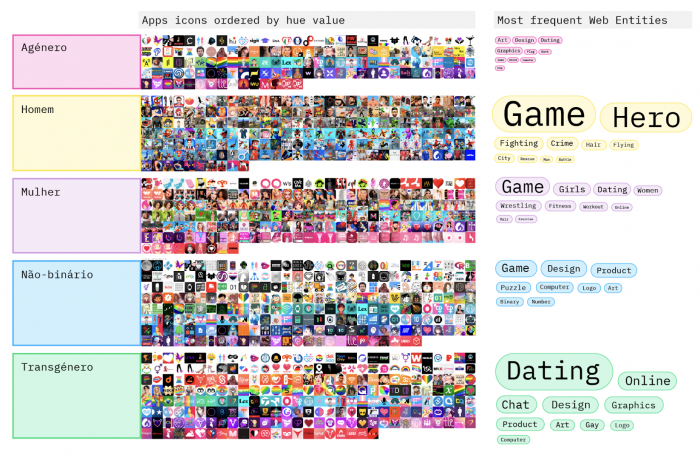
To perform the analysis of visual patterns, we arranged the images in accordance with color within each of the gender-specific style spaces, displaying images side by side in a montage. The practice of doing gender works through repetition, which here we clearly can locate in both color patterns and the content of the icons. What we can see is that the gender stereotypes are in a way still mediated through blue and pink in the male and female binary. Queer genders assemble all colors across the spectrum, with multiple rainbows dispersed across non-binary, a-gender and transgender style spaces.
Within each of the genders, we also looked at the web references to the content of app icons using Google Vision API web entities. Here, again we were confronted with some stereotypes: Apps for men focus on games and Superheroes (the blues), Transgender apps apparently are all about dating, and non-binary apps are very specific in their visuality since they contain icons rather than body images (represented through web references such as design and product).
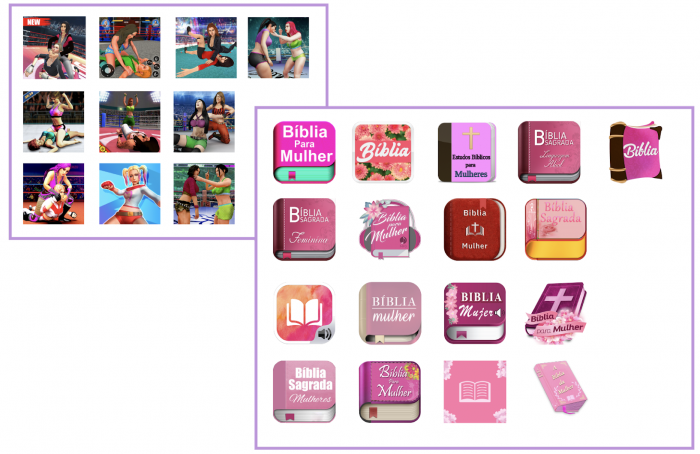
Pink in the female app space: Especially all the bibles are pink, which interestingly is contrasted by quite some apps focusing on female wrestling. What does it tell us about the construction of femininity in Portugal — apparently it’s either praying or wrestling.
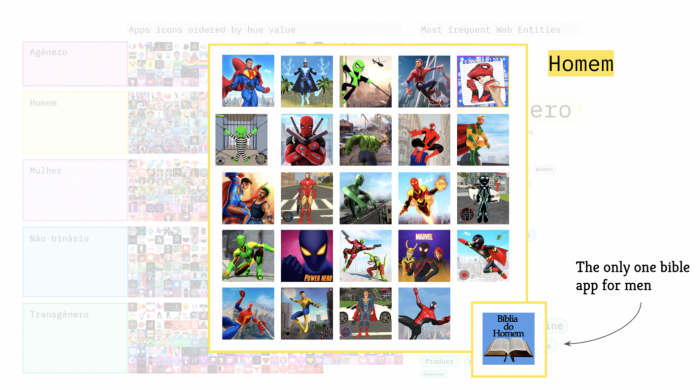
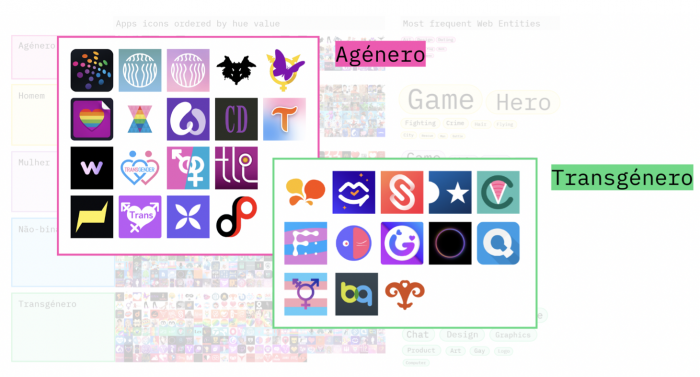
The male and female sexuality are more strongly connected to the other everyday areas of sexual difference, like fitness and health. These male and female apps are more present in the more normative everyday mundane aspects. The queer gender is not yet visible in the normative construction of everyday life, e.g. fitness, entertainment, etc. Even though the app creation “industry” is quite new and open to innovation, it still has a lack of representation reflected in the app sphere.
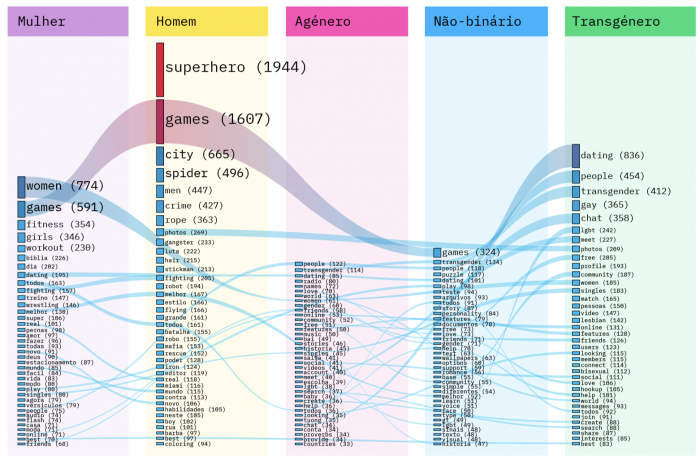
Starting from a simple frequency count of the most repeated words in the app descriptions, we can perceive that some categories are more homogeneous in the type of apps they contain (e.g. men, where superhero and its variations are used almost 2000 times), contrasting to other categories (like non-binary and agender) where words are repeated only a couple of hundred of times, pointing to more heterogeneous groupings of apps. If we look at the rank flow of terms between categories … we see that the men category hardly shares terms with the other categories (and only generic words, like games, photos, or everyone). While women share quite a few words with the gender-queer queries (including women, dating, singles and friends), thus highlighting the dating and social aspect of the apps directed at these genders. Finally, as already mentioned, the three gender-queer categories share a large number of words between them, including those related to dating, but also specific to a queer identity (like LGBTQIA+).
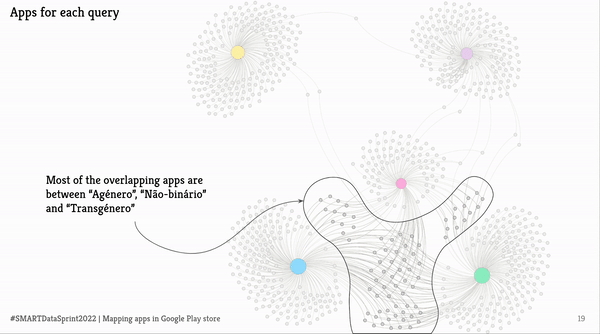
Looking at the overlaps of apps between gender-specific queries we could identify some more related app ecologies (the queer ones) and two less related (male and female). The analysis of unique apps shows a strong presence of the same apps across queer genders (a-gender, non-binary and transgender). Apps for men and women present rather disconnected clusters (with some notable exceptions around gay dating apps + one selfie app for changing gender). The majority of male and female apps are very mainstream and focus on the strict gender binary.
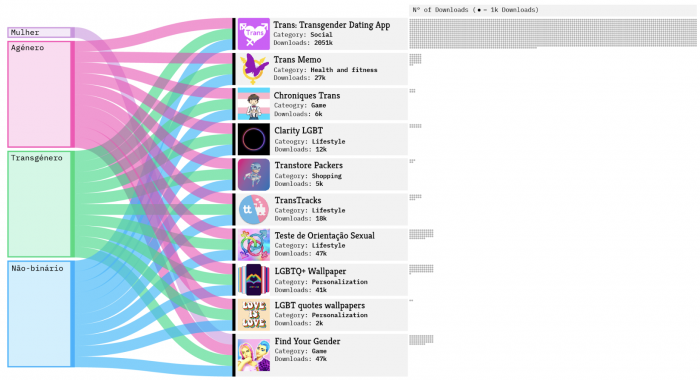
This is a zoom-in with the focus on some of the overlapping laps connecting non-binary, transgender and a-gender queries. Only one app also appears when you search for female apps: Find your gender, which is a game. The categories that Google Play Store assigns to these apps range from games and dating to fitness, shopping and lifestyle.
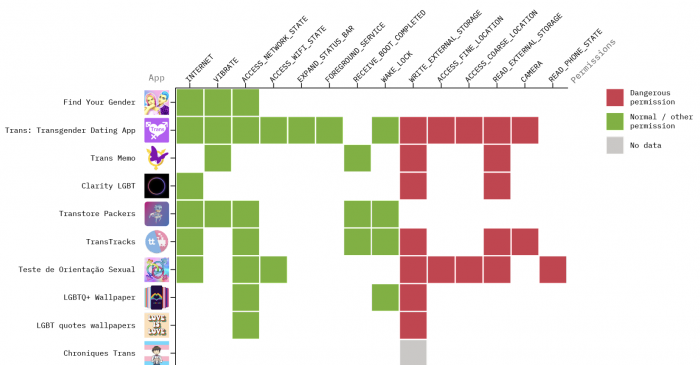
When we look at the specific permissions of the same apps, what we see is a strong tendency of the dating apps to request permissions that the Google App Store identifies as sensitive or potentially dangerous, such as location-based data.
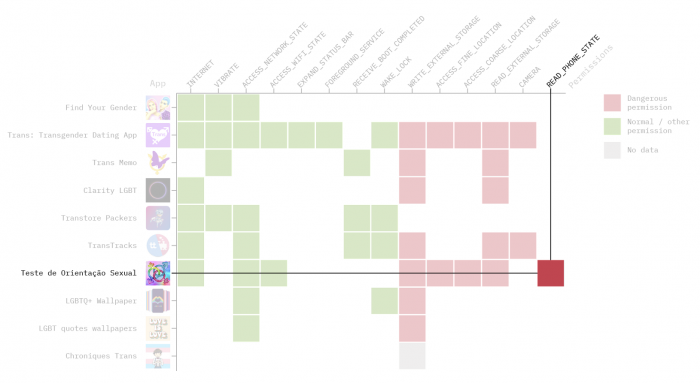
The most intriguing case in terms of permissions is the Portuguese sexuality test app, the only app that requests a reading phone state: A permission which lets the app know your phone number, current cellular network information, and the status of any ongoing calls.
Discussion
We identified three perspectives on sex and sexuality that emerged in the data. We used these categories to code the apps for the similar app recommendation network.
- Sexuality and sexual relationships (e.g. dating)
- Bodily sexual difference (e.g.voice modulation, hormones)
- Appearance and sexualisation (e.g. fitness, beauty)
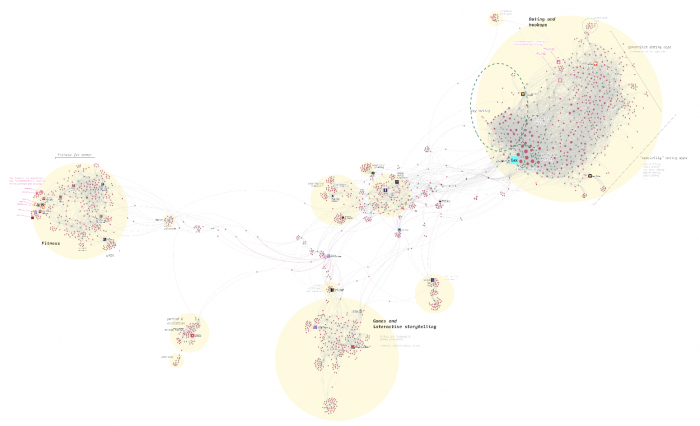
We also created a network based on the similar apps recommended by Google Play Store. From our 344 apps related to sex and sexuality, we extracted 10913 recommended apps (including some overlapping recommendations across our five gender queries).
In the network we can see three main clusters: Dating and Hookups; Games and Interactive storytelling (dedicated to fantasy, roleplaying, and dating simulations); and Fitness (which can be loosely related to different perspectives on sex and sexuality we adopted). Within these clusters, we can also observe subdivisions between a more heteronormative perspective and more queer-related apps (this is very visible in the dating cluster) … or subdivisions between apps directed at women or at men (as we see in the fitness cluster)
It is also interesting to see that some of the fitness and weight loss app recommendations lead us towards the mainstream app ecology — showing apps like Instagram, Pinterest, TikTok, Snapchat, Spotify, Netflix and Zoom. We can also see smaller, but still recognisable, clusters, linked to mental health and wellness, voice training & analysis (coming from the gender-queer queries), or to period and ovulation (apps coming from women query).

We also wanted to explore the visualities of these similar app recommendations and we identified many interesting relations in the ecosystem.
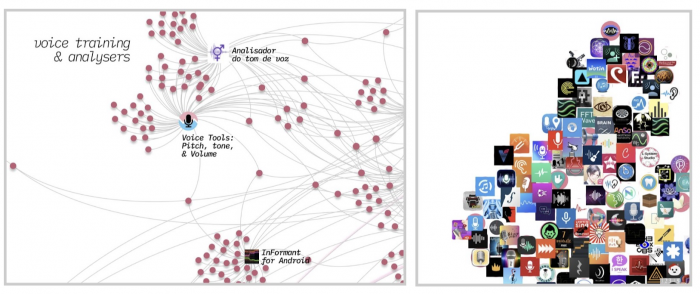
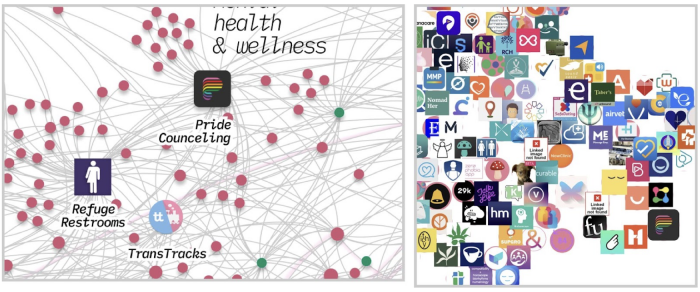
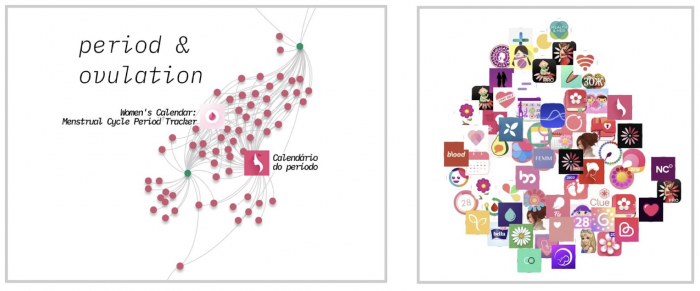
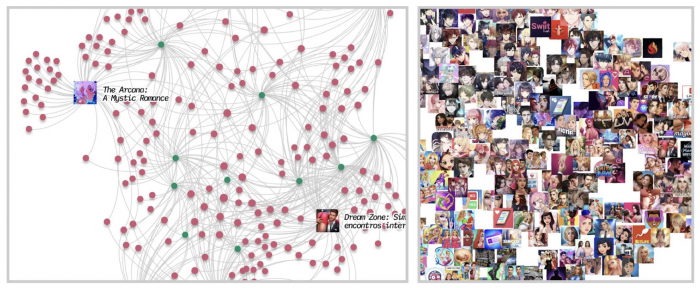
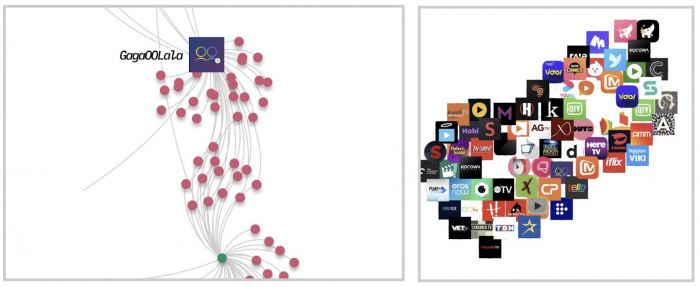
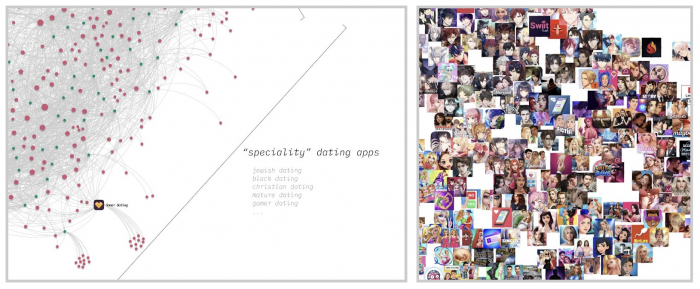
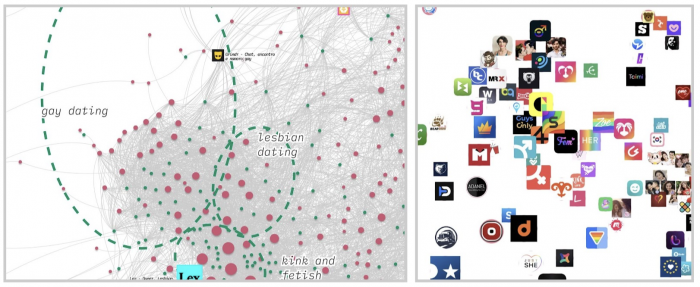
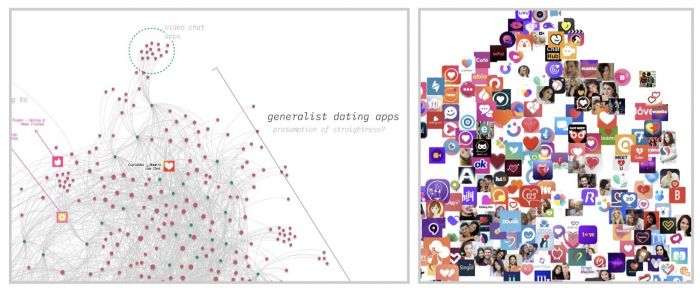
- The visibility of queer genders on Google Play is mediated through the ecology of dating apps. Queer apps are also strongly related to games, you either act your queerness through dating, or your roleplay it in games
- The male and female sexuality are more strongly connected to the other everyday areas of sexual difference, like fitness and health.
- The queer gender is not yet visible in the normative construction of everyday life, e.g. fitness, entertainment, etc.
Rogers, Richard. 2013. Digital Methods. Cambridge, MA: MIT Press.
Dieter, M., Gerlitz, C., Helmond, A., Tkacz, N., van der Vlist, F. N., & Weltevrede, E. (2019). Multi-Situated App Studies: Methods and Propositions. Social Media + Society, 5(2), 205630511984648. https://doi.org/10.1177/2056305119846486
Chao, T. H. J. (2021). AppInspect By Subproject P03 of SFB 1187 “Media of Cooperation” of Uni Siegen. [Software]. Available at https://appinspect.jasontc.net
Chao, Jason (2021). Domain Name Extractor [Software]. Available from https://colab.research.google.com/drive/1NE35PpE05U2TngM5P1wdNI3i-TCqm89-?usp=sharing&fbclid=IwAR27M2C15ge3bzc05ZVXDQUEU-9dDUS7MnkSue8knjvRP4sI2F6P8PCBXeU#scrollTo=g0hbo2LKMaY6
